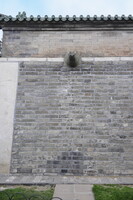Temple of Heaven [complex]
Ming Chengzu, Emperor of China; Ming Shizong, Emperor of China

Download1A2-CH-B-AH-A05_cp.jpg (527.2Kb)
Alternative Titles
Altar of Heaven
Tiāntán
天坛
Date
1406-1420Description
Pathway between enclosure all on the right and the tower area, with pergola arching overhead; The complex was visited by the Emperors of the Ming and Qing dynasties for annual ceremonies of prayer to Heaven for good harvest. It has been regarded as a Taoist temple, although Chinese Heaven worship, especially by the reigning monarch, pre-dates Taoism. The temple complex was constructed from 1406 to 1420 during the reign of the Yongle Emperor (Zhu Di or Ming Chengzu), who was also responsible for the construction of the Forbidden City in Beijing. The complex was extended and renamed Temple of Heaven during the reign of the Jiajing Emperor (reigned 1521-1567). The complex contains three main temple structures: Hall of Prayer for Good Harvests; the Imperial Vault of Heaven; and the Circular Mound Altar. There is also a small palace complex, the Palace of Fasting (Abstinence). A UNESCO World Heritage site. Source: Wikipedia; http://en.wikipedia.org/wiki/Main_Page (accessed 5/29/2013)
Type of Work
temple; altar (religious building fixture)Subject
agriculture, rulers and leaders, Daoist, Ming, Qing
Rights
Rights Statement
Licensed for educational and research use by the MIT community only